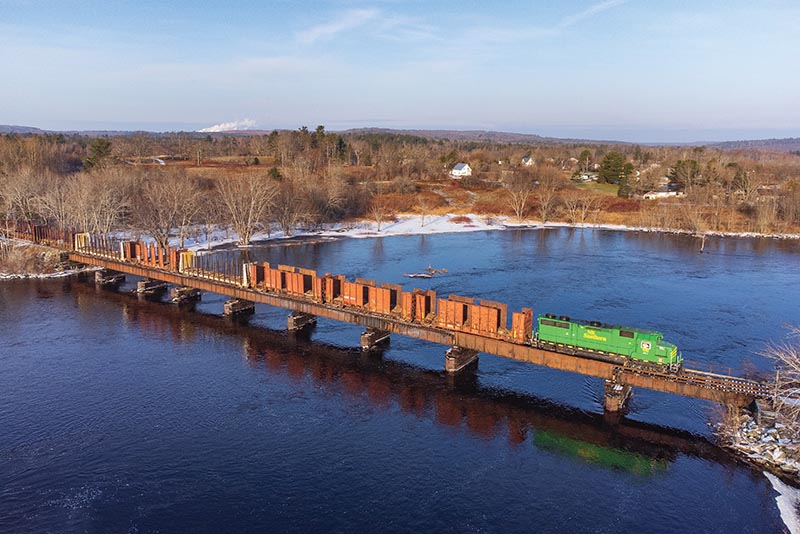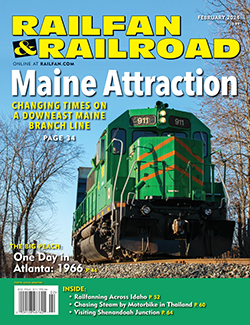 by Lucas Leighton/photos as noted
by Lucas Leighton/photos as noted
The sun slowly rises over the paper mill town of Baileyville, Maine. This small town is one of the first places in the continental U.S. that the sun will hit. While the sun rises, the steady hum of equipment originating from the sprawling pulp and tissue mill cannot be ignored. In between semi-trucks transporting chips and finished products, two vehicles roll into the parking lot of the old Maine Central freight house. As the crew exit their vehicles and go inside to get the morning’s paperwork, so starts the day on the easternmost active railroad in the U.S.
Eastern Maine was once home to some of the busiest rail lines in the state. To the north, Maine Central and Canadian Pacific shared trackage from Mattawamkeag to Vanceboro, on the former European & North American Railway. To the south in the Calais area, MEC had a series of branch lines, connecting Calais with the small town of Baileyville before continuing to Princeton, just shy of 18 miles of track in total. This region, which abuts the Canadian province of New Brunswick, was connected to the rest of the MEC network by the Calais Branch (former Washington County Railroad) that ran from Calais to Brewer. The Calais Branch also hosted the Eastport Branch from Ayers Junction to Eastport, which holds the official title as being the easternmost rail line in the U.S., and the Mount Desert/Waukeag Branch from Washington Junction to McNeil Point.
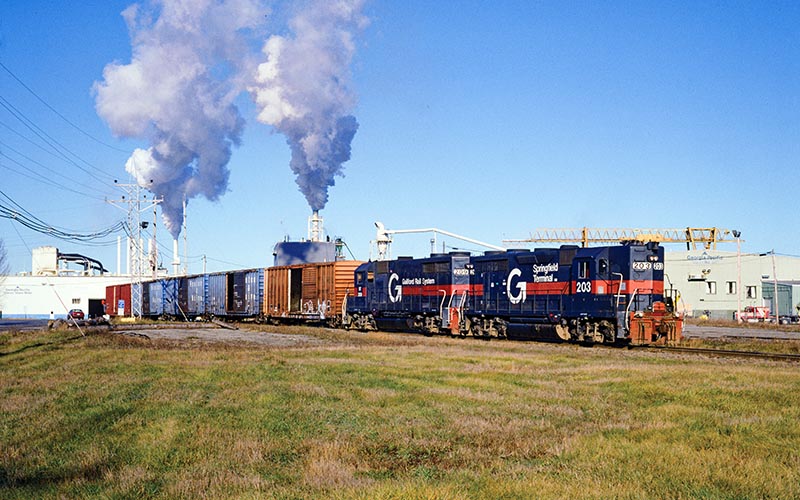
ABOVE: The oriented strand board plant in Woodland was on a one-mile spur that was once the Maine Central line to Princeton and which last saw a train in 1933. In 2002, Georgia-Pacific sold the OSB plant to Louisiana Pacific. The plant ran intermittently from 2002 until late 2004 when it was shut down again. It was still business as usual as a pair of GP35s shoved empties into the loading shed on November 21, 2001. —Mike Peverett photo
The Maine Central empire in this region began to crumble in the 1930s. The Princeton Branch was the first to go in 1933. It was abandoned in 1935 and removed as the few industries along the line closed or moved to trucks. The line was cut back to Baileyville, leaving a wye to the north of the international bridge. Not long after, the 10.8-mile Mount Desert Branch was abandoned and removed after a causeway was built, allowing vehicles to access Mount Desert Island. Traffic remained stable into the 1960s and 1970s, but improvements to State Route 9 and U.S. Route 1 slowly began to pull traffic from the rails and onto trucks.
The Eastport Branch, which had many major traffic sources proposed, ranging from the failed Passamaquoddy Tidal Project to a massive oil refinery, never seemed to reach its full potential as none of the projects ever came to fruition. Operations came to an end in 1978 when the line was abandoned and removed after carloads declined; this made the Woodland Spur/Calais Branch in Calais the nation’s easternmost operating rail line.
The Guilford Era
In 1981, Maine Central was sold to Timothy Mellon, who created Guilford Transportation Industries. Mellon had lofty goals for Guilford, but for the Calais Branch things didn’t look so good. After years of cutbacks by Guilford and failing infrastructure, the CP interchange was moved to Mattawamkeag. With the handful of remaining customers unable to sustain the deteriorating Calais Branch, it was closed in 1987 and abandoned shortly after.
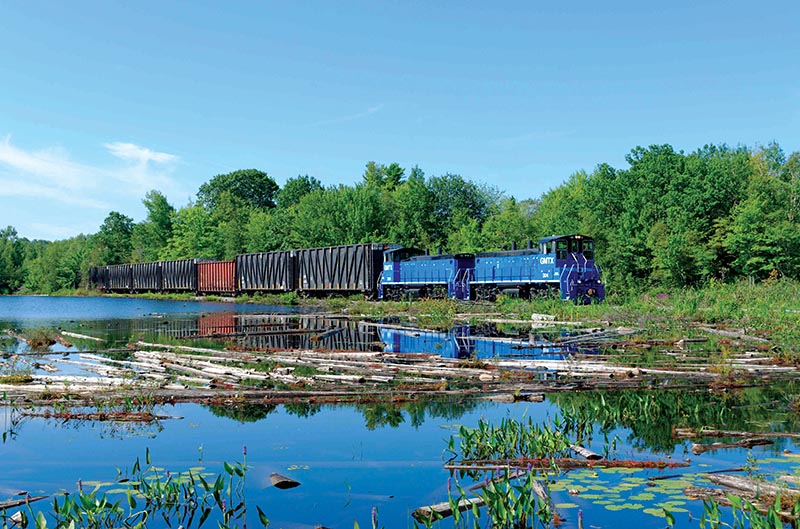
ABOVE: The rear end of the southbound (EMR timetable direction) is still in the yard as it crosses over the backwaters of the St. Croix River upstream from the Woodland Dam on August 16, 2013. In a few car lengths, the train will turn at the wye to head for Calais. The logs in the river are a reminder of the log drives in days long since gone by. —Mike Peverett photo
The track between Greenpoint Road in Brewer and U.S. Route 1 in Calais was abandoned before being taken over by the Maine Department of Transportation a few years later. Guilford retained small amounts of trackage on both ends of the branch, including the Woodland Spur. This was to prevent the Calais Branch from being reopened, which could have potentially competed with the Guilford main line from Northern Maine Junction to Mattawamkeag. This gave Guilford an 11.83-mile branch line isolated from the rest of its network. MDOT turned a portion of the branch into a rail trail in the early 2000s after a failed attempt by New England Southern to reopen the branch. Downeast Scenic Railroad began leasing the section between Washington Junction and the end of MDOT-owned track in Brewer in the late 2000s; it is now one of the most popular tourist railroads in Maine.
The Woodland Spur only ever had a handful of customers throughout its history. The sprawling Woodland Pulp mill in Baileyville, which was established in 1904, and the Georgia-Pacific oriented strand board (OSB) mill located at the north end of the wye, which was built in the early 1970s on the MEC Princeton Branch, were the two main customers. Smaller customers included a trailer-on-flatcar ramp in Baileyville. The mills would receive loads of logs and chemicals used in the papermaking and OSB board-making process, while shipping finished paper, lumber, and OSB via Guilford to the CP interchange at Calais.
During the Guilford era, when locomotives had to be cycled out or repaired, they would go via CP from St. Stephen to McAdam, N.B., then across the border to Mattawamkeag. As the years passed, CP divested itself of its lines east of Montreal due to declining traffic, among other reasons. The trackage west of Brownville Junction was sold to Iron Road Railways which had just purchased Bangor & Aroostook. Iron Road created Canadian American Railway, Quebec Southern, and Northern Vermont Railway. Trackage to the east of Brownville Junction was picked up by J.D. Irving, Ltd., one of the largest companies in Eastern Canada. J.D. Irving formed two railroads under its NBM Railways umbrella, Eastern Maine Railway and New Brunswick Southern Railway. Traffic during this era remained steady, at times requiring a dedicated switcher for the two mills, as well as a road job to Calais which often required at least two locomotives.
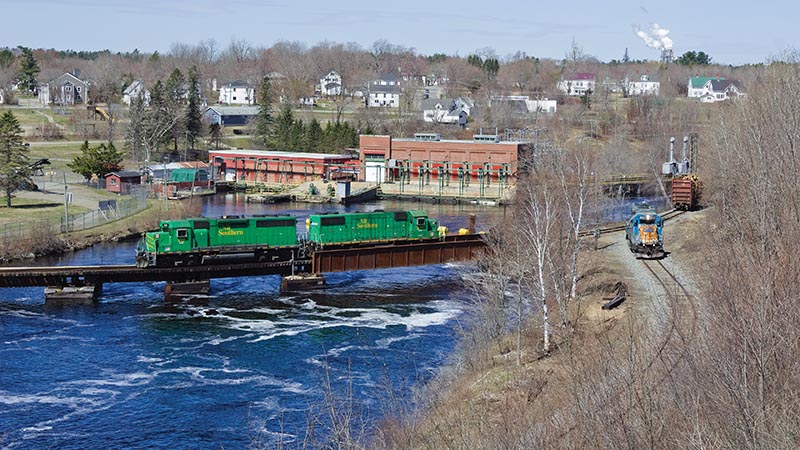
ABOVE: Job 506 on the International Bridge at Calais, with a pair of NBSR GP38s, has just dropped off cars for Job 505, seen on the right, on April 21, 2023. The 505 Job will grab these and head north. —Conner Bray photo
Fast forward to 2002 and things began to decline rapidly. Georgia-Pacific sold the OSB and the adjacent lumber mill to Louisiana Pacific. LP ran the mill on and off between 2002 and 2005, when the mill was officially shut down. This resulted in the loss of around 100 jobs and a large chunk of the line’s traffic. The paper mill, which had various owners over the years, wasn’t faring much better…


